International Management Case: Problem Solving in Tata Company
VerifiedAdded on 2023/06/04
|11
|1912
|423
Case Study
AI Summary
This paper examines the challenges faced by Tata Company in its international management endeavors, focusing on a central leadership deficit that spawned secondary issues such as low-quality production and poor strategy development. It analyzes the company's application of conceptual frameworks, data analysis, and critical reasoning skills to address these problems. Alternative strategies, including the implementation of a chief executive officer, board of directors, and the Tata Business Excellence Model (TBEM), are explored and justified for their relevance to the company's challenges. The paper also discusses the implementation, control, and follow-up measures taken to ensure the effectiveness of these strategies, ultimately contributing to the company's improved competitiveness, financial results, and social interaction. The case study highlights the importance of strong leadership and strategic planning in navigating the complexities of international business and offers valuable insights for other developing businesses. Desklib provides access to similar case studies and solved assignments for students.
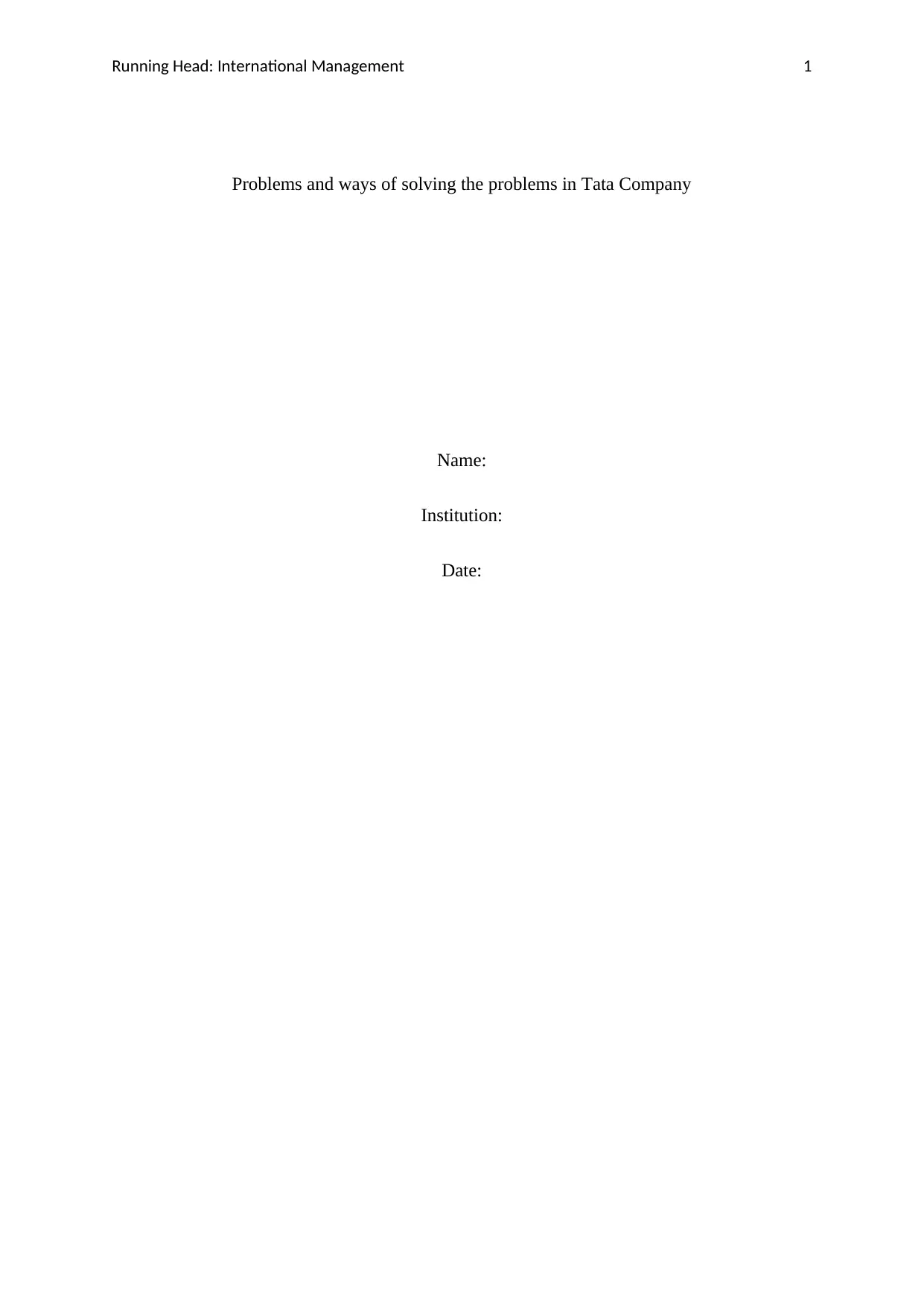
Running Head: International Management 1
Problems and ways of solving the problems in Tata Company
Name:
Institution:
Date:
Problems and ways of solving the problems in Tata Company
Name:
Institution:
Date:
Paraphrase This Document
Need a fresh take? Get an instant paraphrase of this document with our AI Paraphraser
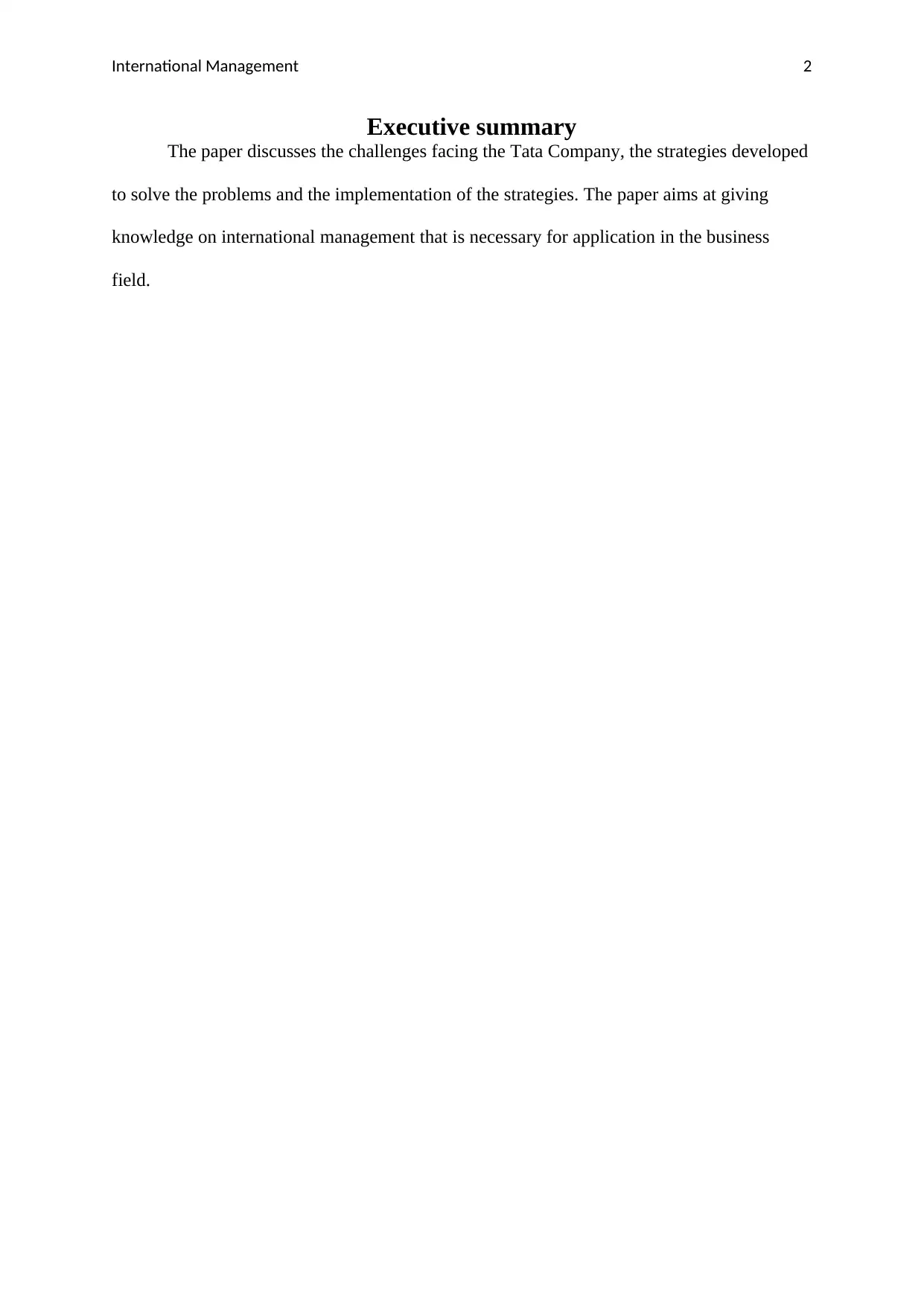
International Management 2
Executive summary
The paper discusses the challenges facing the Tata Company, the strategies developed
to solve the problems and the implementation of the strategies. The paper aims at giving
knowledge on international management that is necessary for application in the business
field.
Executive summary
The paper discusses the challenges facing the Tata Company, the strategies developed
to solve the problems and the implementation of the strategies. The paper aims at giving
knowledge on international management that is necessary for application in the business
field.

International Management 3
Table of Contents
Executive summary....................................................................................................................2
Problems and ways of solving the problems in Tata Company.................................................4
Introduction................................................................................................................................4
Source problem.......................................................................................................................4
Secondary problems...............................................................................................................4
Problem analysis........................................................................................................................4
Application of conceptual frame............................................................................................4
Data analysis...........................................................................................................................5
Use of critical reasoning skills...............................................................................................6
Alternative strategies..................................................................................................................6
Alternatives explored and their relevancies to the company challenges................................6
Justification of recommendations..............................................................................................7
Implementation, control and follow-up......................................................................................8
Conclusion..................................................................................................................................9
References................................................................................................................................10
Table of Contents
Executive summary....................................................................................................................2
Problems and ways of solving the problems in Tata Company.................................................4
Introduction................................................................................................................................4
Source problem.......................................................................................................................4
Secondary problems...............................................................................................................4
Problem analysis........................................................................................................................4
Application of conceptual frame............................................................................................4
Data analysis...........................................................................................................................5
Use of critical reasoning skills...............................................................................................6
Alternative strategies..................................................................................................................6
Alternatives explored and their relevancies to the company challenges................................6
Justification of recommendations..............................................................................................7
Implementation, control and follow-up......................................................................................8
Conclusion..................................................................................................................................9
References................................................................................................................................10
⊘ This is a preview!⊘
Do you want full access?
Subscribe today to unlock all pages.

Trusted by 1+ million students worldwide
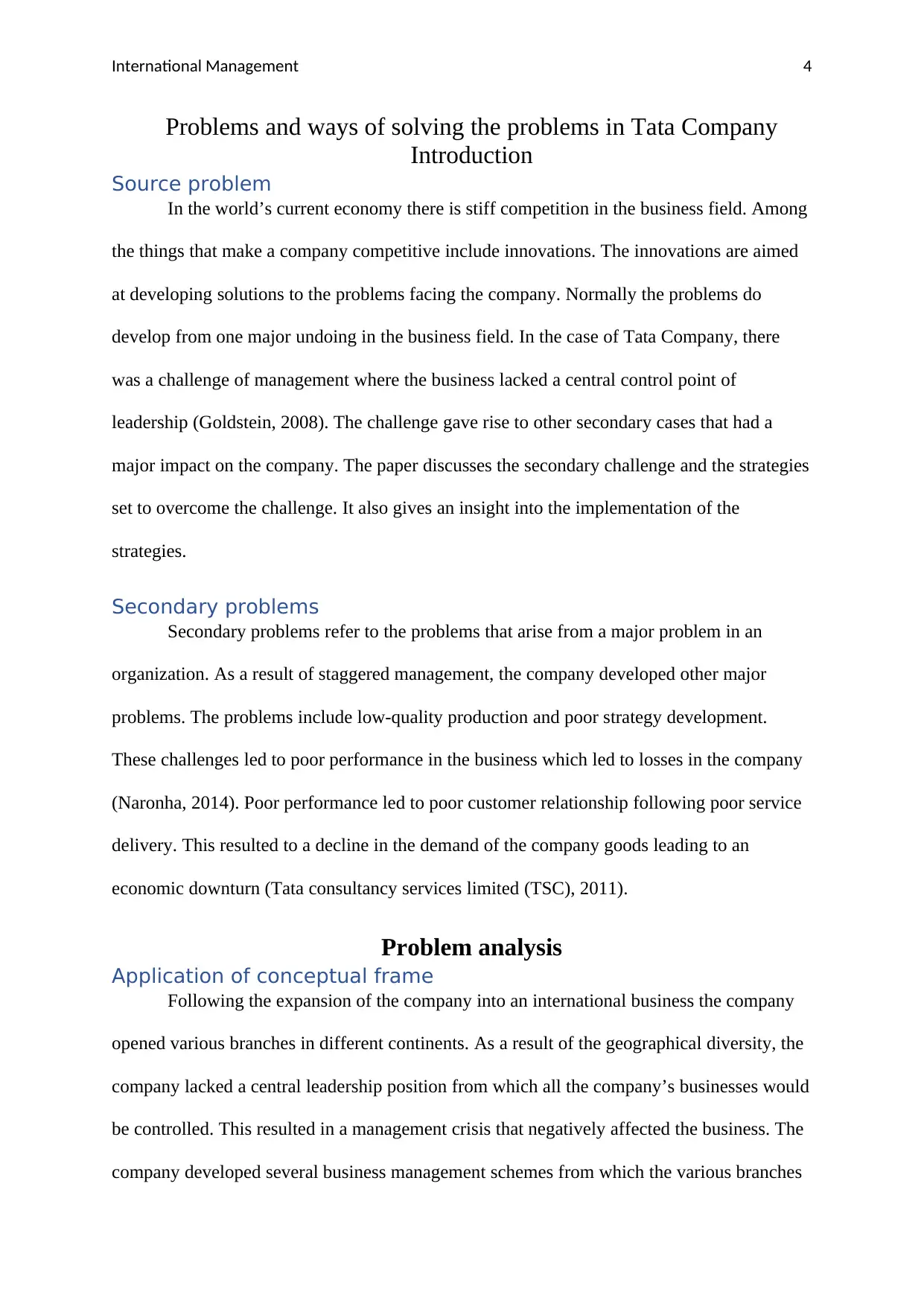
International Management 4
Problems and ways of solving the problems in Tata Company
Introduction
Source problem
In the world’s current economy there is stiff competition in the business field. Among
the things that make a company competitive include innovations. The innovations are aimed
at developing solutions to the problems facing the company. Normally the problems do
develop from one major undoing in the business field. In the case of Tata Company, there
was a challenge of management where the business lacked a central control point of
leadership (Goldstein, 2008). The challenge gave rise to other secondary cases that had a
major impact on the company. The paper discusses the secondary challenge and the strategies
set to overcome the challenge. It also gives an insight into the implementation of the
strategies.
Secondary problems
Secondary problems refer to the problems that arise from a major problem in an
organization. As a result of staggered management, the company developed other major
problems. The problems include low-quality production and poor strategy development.
These challenges led to poor performance in the business which led to losses in the company
(Naronha, 2014). Poor performance led to poor customer relationship following poor service
delivery. This resulted to a decline in the demand of the company goods leading to an
economic downturn (Tata consultancy services limited (TSC), 2011).
Problem analysis
Application of conceptual frame
Following the expansion of the company into an international business the company
opened various branches in different continents. As a result of the geographical diversity, the
company lacked a central leadership position from which all the company’s businesses would
be controlled. This resulted in a management crisis that negatively affected the business. The
company developed several business management schemes from which the various branches
Problems and ways of solving the problems in Tata Company
Introduction
Source problem
In the world’s current economy there is stiff competition in the business field. Among
the things that make a company competitive include innovations. The innovations are aimed
at developing solutions to the problems facing the company. Normally the problems do
develop from one major undoing in the business field. In the case of Tata Company, there
was a challenge of management where the business lacked a central control point of
leadership (Goldstein, 2008). The challenge gave rise to other secondary cases that had a
major impact on the company. The paper discusses the secondary challenge and the strategies
set to overcome the challenge. It also gives an insight into the implementation of the
strategies.
Secondary problems
Secondary problems refer to the problems that arise from a major problem in an
organization. As a result of staggered management, the company developed other major
problems. The problems include low-quality production and poor strategy development.
These challenges led to poor performance in the business which led to losses in the company
(Naronha, 2014). Poor performance led to poor customer relationship following poor service
delivery. This resulted to a decline in the demand of the company goods leading to an
economic downturn (Tata consultancy services limited (TSC), 2011).
Problem analysis
Application of conceptual frame
Following the expansion of the company into an international business the company
opened various branches in different continents. As a result of the geographical diversity, the
company lacked a central leadership position from which all the company’s businesses would
be controlled. This resulted in a management crisis that negatively affected the business. The
company developed several business management schemes from which the various branches
Paraphrase This Document
Need a fresh take? Get an instant paraphrase of this document with our AI Paraphraser
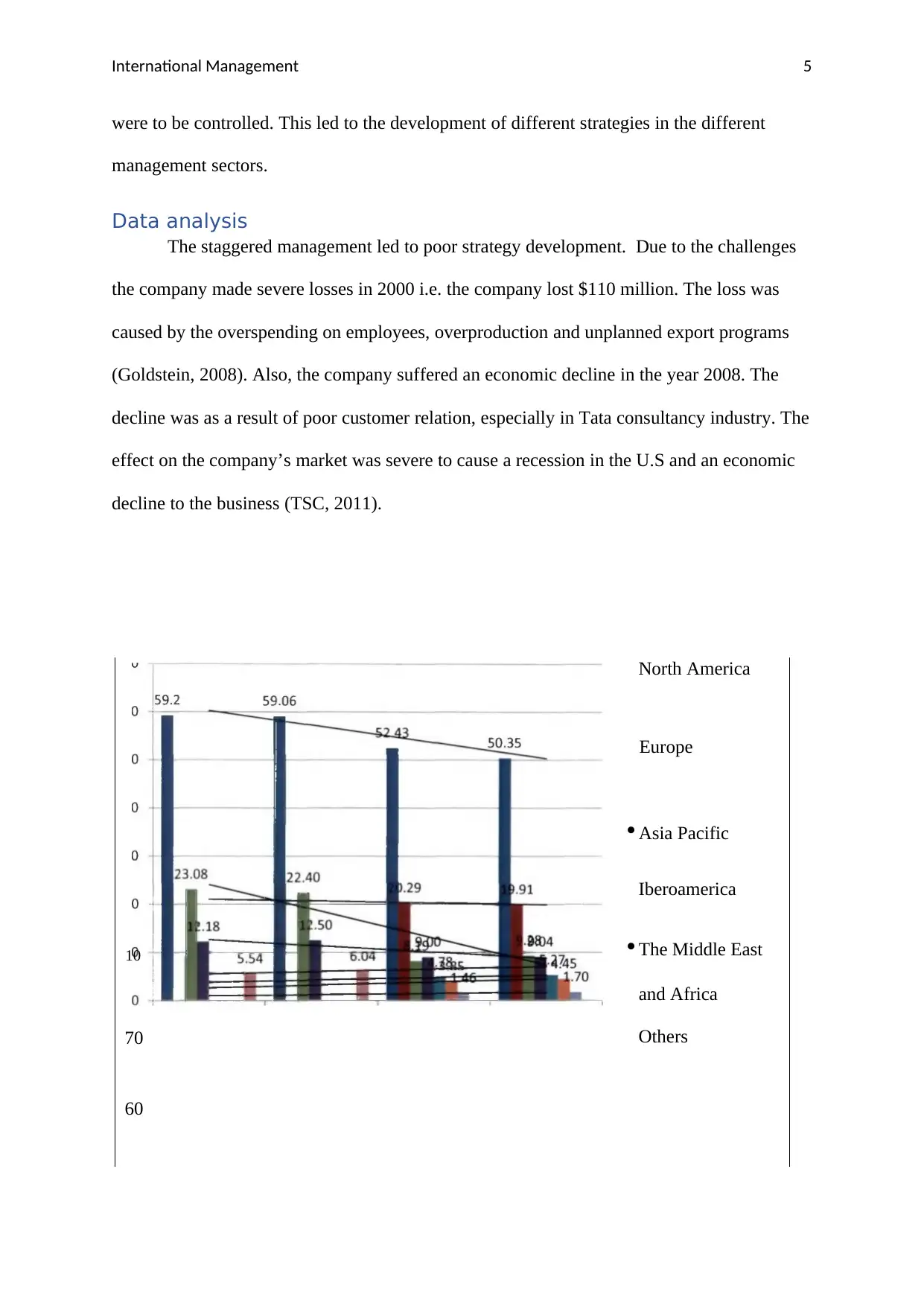
International Management 5
were to be controlled. This led to the development of different strategies in the different
management sectors.
Data analysis
The staggered management led to poor strategy development. Due to the challenges
the company made severe losses in 2000 i.e. the company lost $110 million. The loss was
caused by the overspending on employees, overproduction and unplanned export programs
(Goldstein, 2008). Also, the company suffered an economic decline in the year 2008. The
decline was as a result of poor customer relation, especially in Tata consultancy industry. The
effect on the company’s market was severe to cause a recession in the U.S and an economic
decline to the business (TSC, 2011).
70
60
North America
Europe
•Asia Pacific
Iberoamerica
•The Middle East
and Africa
Others
10
were to be controlled. This led to the development of different strategies in the different
management sectors.
Data analysis
The staggered management led to poor strategy development. Due to the challenges
the company made severe losses in 2000 i.e. the company lost $110 million. The loss was
caused by the overspending on employees, overproduction and unplanned export programs
(Goldstein, 2008). Also, the company suffered an economic decline in the year 2008. The
decline was as a result of poor customer relation, especially in Tata consultancy industry. The
effect on the company’s market was severe to cause a recession in the U.S and an economic
decline to the business (TSC, 2011).
70
60
North America
Europe
•Asia Pacific
Iberoamerica
•The Middle East
and Africa
Others
10
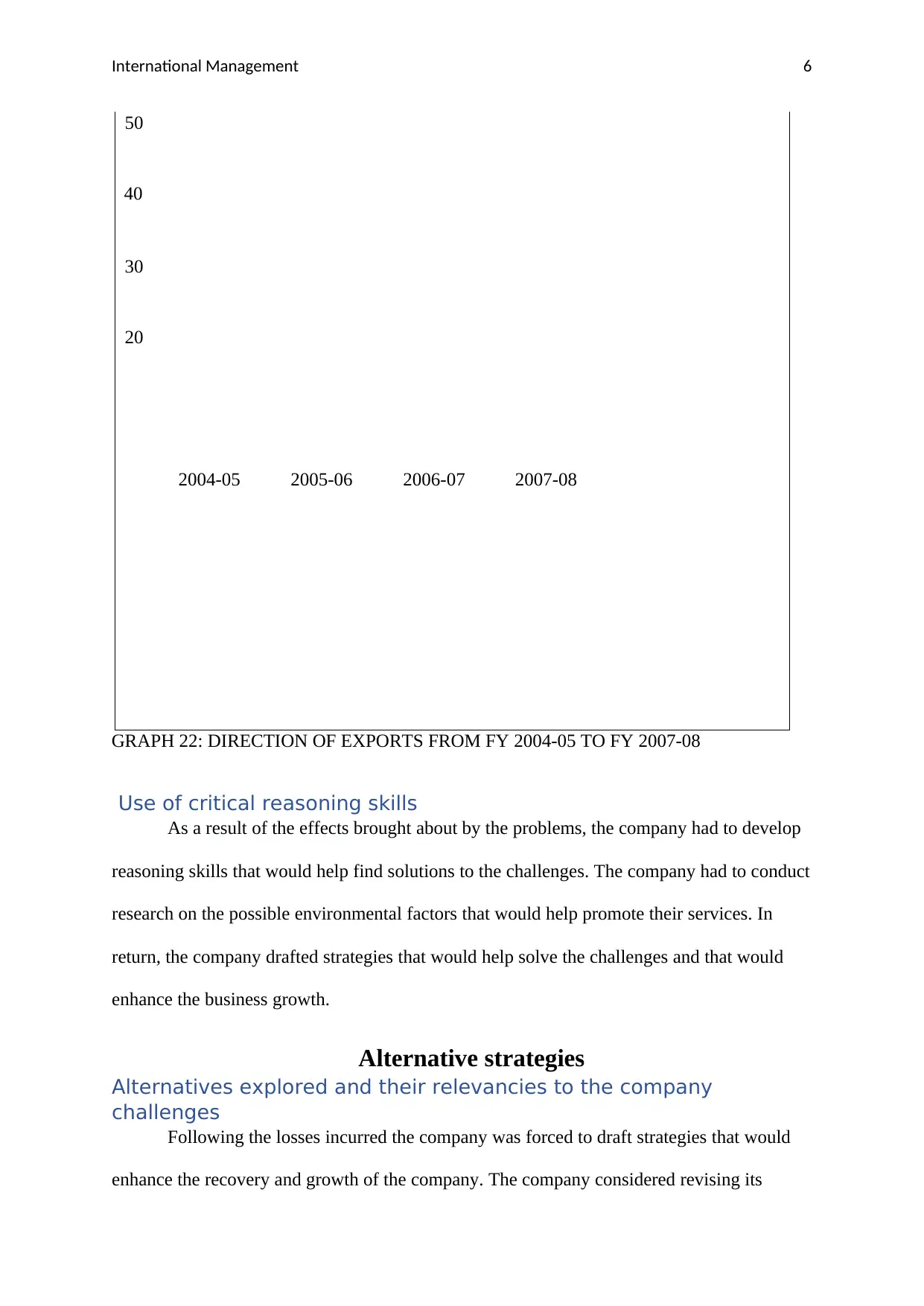
International Management 6
50
40
30
20
2004-05 2005-06 2006-07 2007-08
GRAPH 22: DIRECTION OF EXPORTS FROM FY 2004-05 TO FY 2007-08
Use of critical reasoning skills
As a result of the effects brought about by the problems, the company had to develop
reasoning skills that would help find solutions to the challenges. The company had to conduct
research on the possible environmental factors that would help promote their services. In
return, the company drafted strategies that would help solve the challenges and that would
enhance the business growth.
Alternative strategies
Alternatives explored and their relevancies to the company
challenges
Following the losses incurred the company was forced to draft strategies that would
enhance the recovery and growth of the company. The company considered revising its
50
40
30
20
2004-05 2005-06 2006-07 2007-08
GRAPH 22: DIRECTION OF EXPORTS FROM FY 2004-05 TO FY 2007-08
Use of critical reasoning skills
As a result of the effects brought about by the problems, the company had to develop
reasoning skills that would help find solutions to the challenges. The company had to conduct
research on the possible environmental factors that would help promote their services. In
return, the company drafted strategies that would help solve the challenges and that would
enhance the business growth.
Alternative strategies
Alternatives explored and their relevancies to the company
challenges
Following the losses incurred the company was forced to draft strategies that would
enhance the recovery and growth of the company. The company considered revising its
⊘ This is a preview!⊘
Do you want full access?
Subscribe today to unlock all pages.

Trusted by 1+ million students worldwide

International Management 7
leadership so as to have a central leadership through which all the company’s activities would
be discussed. The developed management include a chief executive officer, board of directors
and shareholder. The company also has a branch responsible for the company’s major
investments known as Tata sons (Singh & Manavalan, 2012). This development was aimed at
solving the existing management problem in the company.
The company also developed the Tata Business Excellence Model. The model was to
enhance development in the leadership and the strategic planning of the company. The model
would also help improve employee performance through the assessment of their performance.
It would also give an insight into the workforce and recommend for the necessary changes in
the field. In line with the Tata sons sector, the model would enhance innovation in the
company. The model also helped in developing the Cooperate Social Responsibility sector in
the business by giving an insight on the company’s workforce and performing of assessment
to analyze their contribution (Jayaraman, 2016). As a result, the TBEM model defined the
responsibilities that each stakeholder was to play in the business recovery and growth
process. The various strategies helped develop innovation in the business and enhance
individual responsibility in the organization.
Justification of recommendations
Leadership is a key factor in the development of a business. Leadership develops
motivation among the company stakeholders to work hard towards achieving the goals of a
business. It also helps in the development of strategies that enhance business growth (Hao &
Yazdanifard, 2015). The decision by the Tata Company to review the leadership sector has
played a great role in the achievement of the business goals and growth. The new
management developed new strategies to enhance business growth. The strategies include;
one, the development of a body responsible for the company investment and development i.e.
TATA Sons. The branch has ensured the development of production technology that has
leadership so as to have a central leadership through which all the company’s activities would
be discussed. The developed management include a chief executive officer, board of directors
and shareholder. The company also has a branch responsible for the company’s major
investments known as Tata sons (Singh & Manavalan, 2012). This development was aimed at
solving the existing management problem in the company.
The company also developed the Tata Business Excellence Model. The model was to
enhance development in the leadership and the strategic planning of the company. The model
would also help improve employee performance through the assessment of their performance.
It would also give an insight into the workforce and recommend for the necessary changes in
the field. In line with the Tata sons sector, the model would enhance innovation in the
company. The model also helped in developing the Cooperate Social Responsibility sector in
the business by giving an insight on the company’s workforce and performing of assessment
to analyze their contribution (Jayaraman, 2016). As a result, the TBEM model defined the
responsibilities that each stakeholder was to play in the business recovery and growth
process. The various strategies helped develop innovation in the business and enhance
individual responsibility in the organization.
Justification of recommendations
Leadership is a key factor in the development of a business. Leadership develops
motivation among the company stakeholders to work hard towards achieving the goals of a
business. It also helps in the development of strategies that enhance business growth (Hao &
Yazdanifard, 2015). The decision by the Tata Company to review the leadership sector has
played a great role in the achievement of the business goals and growth. The new
management developed new strategies to enhance business growth. The strategies include;
one, the development of a body responsible for the company investment and development i.e.
TATA Sons. The branch has ensured the development of production technology that has
Paraphrase This Document
Need a fresh take? Get an instant paraphrase of this document with our AI Paraphraser
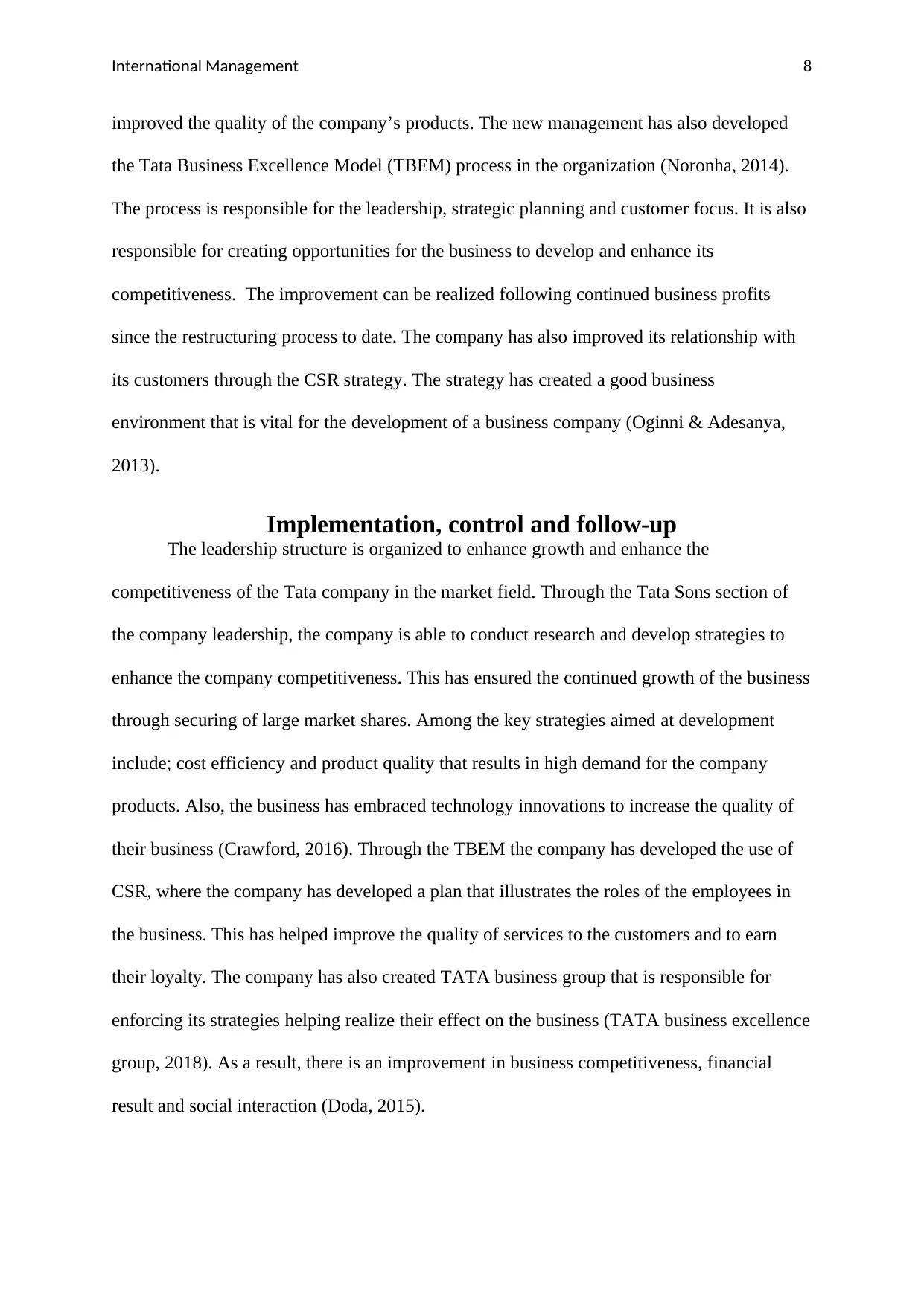
International Management 8
improved the quality of the company’s products. The new management has also developed
the Tata Business Excellence Model (TBEM) process in the organization (Noronha, 2014).
The process is responsible for the leadership, strategic planning and customer focus. It is also
responsible for creating opportunities for the business to develop and enhance its
competitiveness. The improvement can be realized following continued business profits
since the restructuring process to date. The company has also improved its relationship with
its customers through the CSR strategy. The strategy has created a good business
environment that is vital for the development of a business company (Oginni & Adesanya,
2013).
Implementation, control and follow-up
The leadership structure is organized to enhance growth and enhance the
competitiveness of the Tata company in the market field. Through the Tata Sons section of
the company leadership, the company is able to conduct research and develop strategies to
enhance the company competitiveness. This has ensured the continued growth of the business
through securing of large market shares. Among the key strategies aimed at development
include; cost efficiency and product quality that results in high demand for the company
products. Also, the business has embraced technology innovations to increase the quality of
their business (Crawford, 2016). Through the TBEM the company has developed the use of
CSR, where the company has developed a plan that illustrates the roles of the employees in
the business. This has helped improve the quality of services to the customers and to earn
their loyalty. The company has also created TATA business group that is responsible for
enforcing its strategies helping realize their effect on the business (TATA business excellence
group, 2018). As a result, there is an improvement in business competitiveness, financial
result and social interaction (Doda, 2015).
improved the quality of the company’s products. The new management has also developed
the Tata Business Excellence Model (TBEM) process in the organization (Noronha, 2014).
The process is responsible for the leadership, strategic planning and customer focus. It is also
responsible for creating opportunities for the business to develop and enhance its
competitiveness. The improvement can be realized following continued business profits
since the restructuring process to date. The company has also improved its relationship with
its customers through the CSR strategy. The strategy has created a good business
environment that is vital for the development of a business company (Oginni & Adesanya,
2013).
Implementation, control and follow-up
The leadership structure is organized to enhance growth and enhance the
competitiveness of the Tata company in the market field. Through the Tata Sons section of
the company leadership, the company is able to conduct research and develop strategies to
enhance the company competitiveness. This has ensured the continued growth of the business
through securing of large market shares. Among the key strategies aimed at development
include; cost efficiency and product quality that results in high demand for the company
products. Also, the business has embraced technology innovations to increase the quality of
their business (Crawford, 2016). Through the TBEM the company has developed the use of
CSR, where the company has developed a plan that illustrates the roles of the employees in
the business. This has helped improve the quality of services to the customers and to earn
their loyalty. The company has also created TATA business group that is responsible for
enforcing its strategies helping realize their effect on the business (TATA business excellence
group, 2018). As a result, there is an improvement in business competitiveness, financial
result and social interaction (Doda, 2015).

International Management 9
Conclusion
Tata Company has been developing in recent years following its business
development strategies. Good leadership has also played a great role in the development and
growth of the company. It has enforced helped develop the business strategies and enforced
for their implementation. The company serves as an example to other upcoming and
developing businesses.
Conclusion
Tata Company has been developing in recent years following its business
development strategies. Good leadership has also played a great role in the development and
growth of the company. It has enforced helped develop the business strategies and enforced
for their implementation. The company serves as an example to other upcoming and
developing businesses.
⊘ This is a preview!⊘
Do you want full access?
Subscribe today to unlock all pages.

Trusted by 1+ million students worldwide
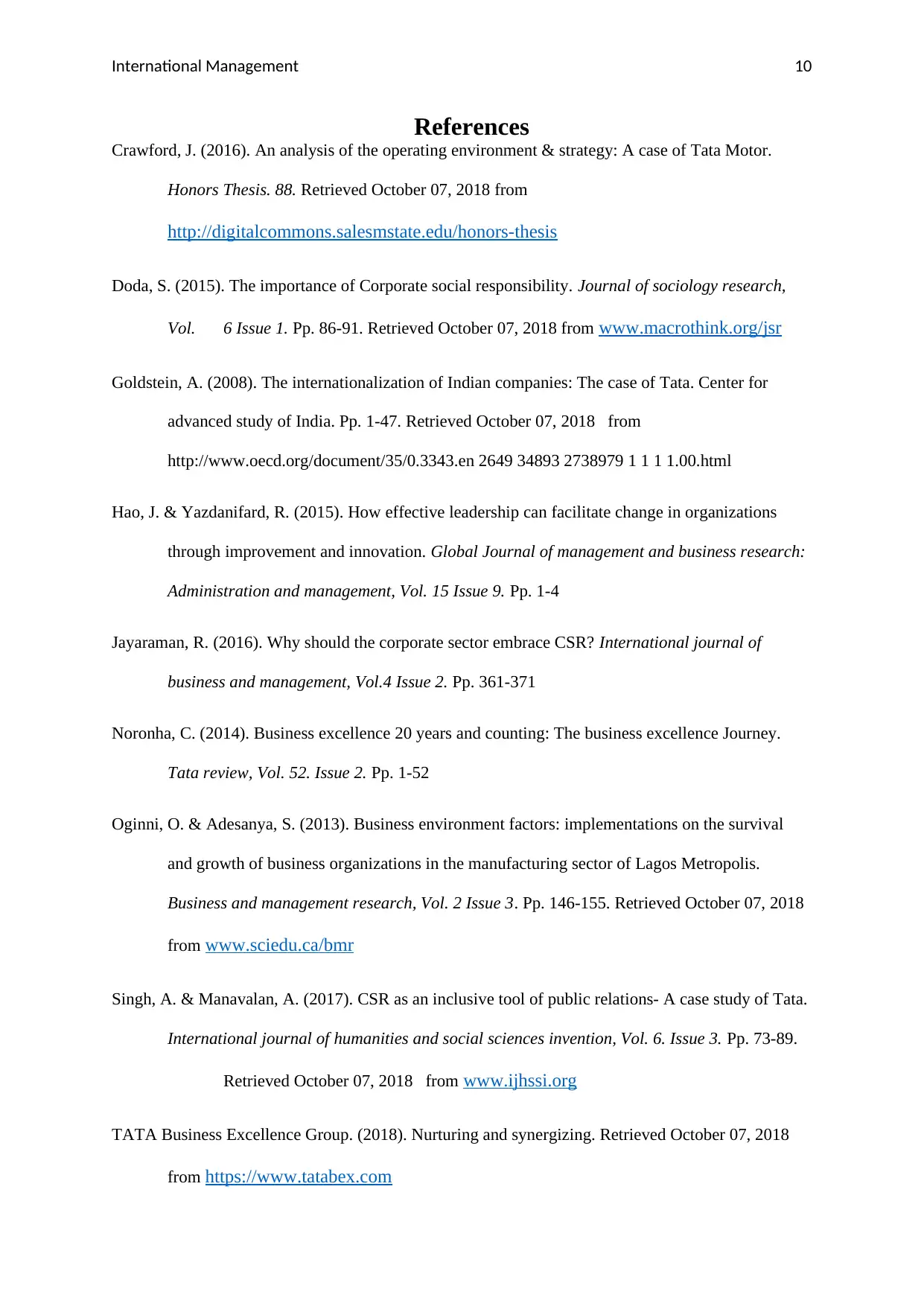
International Management 10
References
Crawford, J. (2016). An analysis of the operating environment & strategy: A case of Tata Motor.
Honors Thesis. 88. Retrieved October 07, 2018 from
http://digitalcommons.salesmstate.edu/honors-thesis
Doda, S. (2015). The importance of Corporate social responsibility. Journal of sociology research,
Vol. 6 Issue 1. Pp. 86-91. Retrieved October 07, 2018 from www.macrothink.org/jsr
Goldstein, A. (2008). The internationalization of Indian companies: The case of Tata. Center for
advanced study of India. Pp. 1-47. Retrieved October 07, 2018 from
http://www.oecd.org/document/35/0.3343.en 2649 34893 2738979 1 1 1 1.00.html
Hao, J. & Yazdanifard, R. (2015). How effective leadership can facilitate change in organizations
through improvement and innovation. Global Journal of management and business research:
Administration and management, Vol. 15 Issue 9. Pp. 1-4
Jayaraman, R. (2016). Why should the corporate sector embrace CSR? International journal of
business and management, Vol.4 Issue 2. Pp. 361-371
Noronha, C. (2014). Business excellence 20 years and counting: The business excellence Journey.
Tata review, Vol. 52. Issue 2. Pp. 1-52
Oginni, O. & Adesanya, S. (2013). Business environment factors: implementations on the survival
and growth of business organizations in the manufacturing sector of Lagos Metropolis.
Business and management research, Vol. 2 Issue 3. Pp. 146-155. Retrieved October 07, 2018
from www.sciedu.ca/bmr
Singh, A. & Manavalan, A. (2017). CSR as an inclusive tool of public relations- A case study of Tata.
International journal of humanities and social sciences invention, Vol. 6. Issue 3. Pp. 73-89.
Retrieved October 07, 2018 from www.ijhssi.org
TATA Business Excellence Group. (2018). Nurturing and synergizing. Retrieved October 07, 2018
from https://www.tatabex.com
References
Crawford, J. (2016). An analysis of the operating environment & strategy: A case of Tata Motor.
Honors Thesis. 88. Retrieved October 07, 2018 from
http://digitalcommons.salesmstate.edu/honors-thesis
Doda, S. (2015). The importance of Corporate social responsibility. Journal of sociology research,
Vol. 6 Issue 1. Pp. 86-91. Retrieved October 07, 2018 from www.macrothink.org/jsr
Goldstein, A. (2008). The internationalization of Indian companies: The case of Tata. Center for
advanced study of India. Pp. 1-47. Retrieved October 07, 2018 from
http://www.oecd.org/document/35/0.3343.en 2649 34893 2738979 1 1 1 1.00.html
Hao, J. & Yazdanifard, R. (2015). How effective leadership can facilitate change in organizations
through improvement and innovation. Global Journal of management and business research:
Administration and management, Vol. 15 Issue 9. Pp. 1-4
Jayaraman, R. (2016). Why should the corporate sector embrace CSR? International journal of
business and management, Vol.4 Issue 2. Pp. 361-371
Noronha, C. (2014). Business excellence 20 years and counting: The business excellence Journey.
Tata review, Vol. 52. Issue 2. Pp. 1-52
Oginni, O. & Adesanya, S. (2013). Business environment factors: implementations on the survival
and growth of business organizations in the manufacturing sector of Lagos Metropolis.
Business and management research, Vol. 2 Issue 3. Pp. 146-155. Retrieved October 07, 2018
from www.sciedu.ca/bmr
Singh, A. & Manavalan, A. (2017). CSR as an inclusive tool of public relations- A case study of Tata.
International journal of humanities and social sciences invention, Vol. 6. Issue 3. Pp. 73-89.
Retrieved October 07, 2018 from www.ijhssi.org
TATA Business Excellence Group. (2018). Nurturing and synergizing. Retrieved October 07, 2018
from https://www.tatabex.com
Paraphrase This Document
Need a fresh take? Get an instant paraphrase of this document with our AI Paraphraser
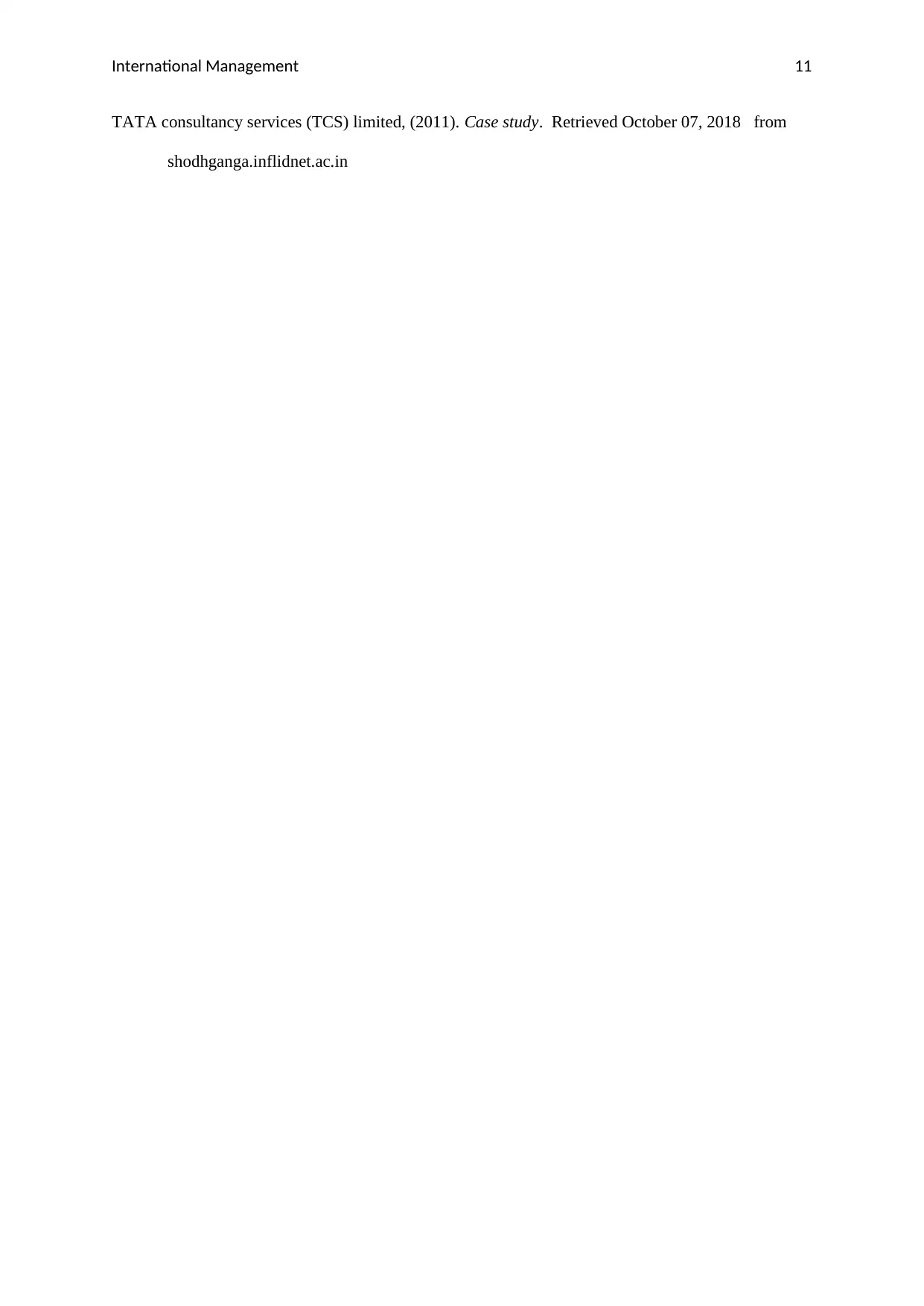
International Management 11
TATA consultancy services (TCS) limited, (2011). Case study. Retrieved October 07, 2018 from
shodhganga.inflidnet.ac.in
TATA consultancy services (TCS) limited, (2011). Case study. Retrieved October 07, 2018 from
shodhganga.inflidnet.ac.in
1 out of 11
Related Documents
Your All-in-One AI-Powered Toolkit for Academic Success.
+13062052269
info@desklib.com
Available 24*7 on WhatsApp / Email
![[object Object]](/_next/static/media/star-bottom.7253800d.svg)
Unlock your academic potential
Copyright © 2020–2025 A2Z Services. All Rights Reserved. Developed and managed by ZUCOL.





